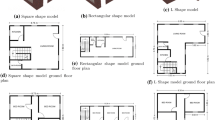Abstract
Thermal comfort and energy saving are objectives of key significance that building design must meet. Since a low energy building can be obtained as a result of the good realization of all its components, roofs call for particular attention as they represent a large part of a building’s total surface area. In this paper the benefit of using ventilated roofs for reducing summer cooling load is investigated. The investigation has been conducted comparing a ventilated roof assembly with different channel heights (3 cm, 5 cm, and 10 cm) to the same non ventilated structure, assuming buoyancy-driven airflow. Direct comparison between the open and the closed roof structures as a function of different cavity heights and outside environmental conditions is presented. To provide fundamental information about the thermal performance of these building envelope components, the computational fluid dynamics (CFD) model has been used to develop correlations for the characterization of the airflow and heat transfer phenomena in the ventilation cavity which have been implemented in a whole year energy simulation software. The present analysis shows a conflicting discrepancy among the indexes of performance describing the actual energy saving potential of a ventilated roof.
Similar content being viewed by others
Abbreviations
- a :
-
solar absorptance
- c p :
-
specific heat (J/(kg·K))
- Gr :
-
Grashof number
- h :
-
overall heat transfer coefficient (W/(m2·K))
- I :
-
solar radiation (W/m2)
- k :
-
thermal conductivity (W/(m·K))
- ṁ :
-
mass flow rate (kg/s)
- Nu :
-
Nusselt number
- Ra :
-
Rayleigh number
- Re :
-
Renolds number
- p :
-
pressure (Pa)
- Q :
-
heat flux crossing the ventilated roof (W/m2)
- Q 0 :
-
resulting heat flux when the ventilation channel is kept closed (W/m2)
- Q 1 :
-
resulting heat flux for the case with thickened insulation (W/m2)
- Q air :
-
air heat gain (W)
- S :
-
dimensionless performance index
- T :
-
temperature (K)
- u i,j,k :
-
components of the velocity according to i, j, k (m/s)
- V :
-
volumetric flow rate (m3/h)
- cav:
-
cavity air bulk conditions
- conv:
-
convective
- ext:
-
external conditions
- in:
-
inlet conditions
- L:
-
cavity length
- out:
-
outlet conditions
- s:
-
cavity spacing
- sa:
-
sol-air
- w:
-
wall
References
Antvorskov S (2008). Introduction to integration of renewable energy in demand controlled hybrid ventilation systems for residential buildings. Building and Environment, 43: 1350–1353.
Azevedo LFA, Sparrow EM (1985). Natural convection in open ended inclined channels. Journal of Heat Transfer, 107: 893–901.
Biwole PH, Woloszyn M, Pompeo C (2008). Heat transfers in a double-skin roof ventilated by natural convection in summer time. Energy and Buildings, 40: 1487–1497.
CEN (2007). EN 6946—Building components and building elements—Thermal resistance and thermal transmittance—Calculation method. Brussels: European Committee for Standardization.
Černe B, Medved S (2007). Determination of transient two-dimensional heat transfer in ventilated lightweight low sloped roof using Fourier series. Building and Environment, 42: 2279–2288.
Ciampi M, Leccese F, Tuono G (2005). Energy analysis of ventilated and microventilated roofs. Solar Energy, 79: 183–192.
Dimoudi A, Androutsopoulos A, Lykoudis, S (2006a). Summer performance of a ventilated roof component. Energy and Buildings, 38: 610–617.
Dimoudi A, Lykoudis S, Androutsopoulos A (2006b). Thermal performance of a innovative roof component. Renewable Energy, 31: 2257–2271.
Fluent Inc (2006). Fluent User’s Guide, Version 6.3. Lebanon, USA.
Hensen J (1995). Modelling coupled heat and air flow: Ping-pong vs onions. In: Proceedings of the 16th AIVC Conference, Palm Springs, pp. 253–262.
Hinze JO (1959). Turbulence. New York: Mc Graw-Hill Book Company.
Hirunlabh J, Wachirapuwadon S, Pratinthong N, Khedari J (2001). New configurations of a roof solar collector maximizing natural ventilation. Building and Environment, 36: 383–391.
James DL, Webb SW (2004). Turbulent natural convection heat transfer in a square enclosure: Turbulence model comparisons, In: Proceedings of 2004 ASME Heat Transfer/Fluids Engineering Summer Conference, Charlotte, North Carolina, USA.
Khedari J, Yimsamerjit P, Hirunlabh J (2002). Experimental investigation of free convection in roof solar collector. Building and Environment, 37: 455–459.
Lai C, Huang JY, Chiou JS (2008). Optimal spacing for double-skin roofs. Building and Environment, 40: 1749–1754.
Omer AM (2008). Renewable building energy systems and passive human comfort solutions. Renewable & Sustainable Energy Reviews, 12: 1562–1587.
Pappas A, Zhai Z (2008). Numerical investigation on thermal performance and correlations of double skin facade with buoyancy-driven airflow. Energy and Buildings, 40: 466–475.
Saelens D (2002). Energy performance assessment of multiple-skin facades. PhD Dissertation, Katholieke Universiteit, Leuven, Belgium.
Sandberg M, Moshfegh B (1998). Ventilated-solar roof air flow and heat transfer investigation. Renewable Energy, 15: 287–292.
Santamouris M, Papanikolaou N, Livada I, Koronakis I, Georgakis C, Argiriou A, Assimakopoulos DN (2001). On the impact of urban climate on the energy consumption of buildings. Solar Energy, 70(3): 201–216.
TRNSYS (2000). TRNSYS: A transient simulation program, reference manual. Solar Energy Lab, University of Wisconsin-Madison, Wisconsin, USA.
Zhai Z, Chen Q, Haves P, Klems JH (2002). On approaches to couple energy simulation and computational fluid dynamics programs. Building and Environment, 37: 857–864.
Author information
Authors and Affiliations
Corresponding author
Rights and permissions
About this article
Cite this article
Villi, G., Pasut, W. & Carli, M.D. CFD modelling and thermal performance analysis of a wooden ventilated roof structure. Build. Simul. 2, 215–228 (2009). https://doi.org/10.1007/s12273-009-9414-7
Received:
Revised:
Accepted:
Published:
Issue Date:
DOI: https://doi.org/10.1007/s12273-009-9414-7




